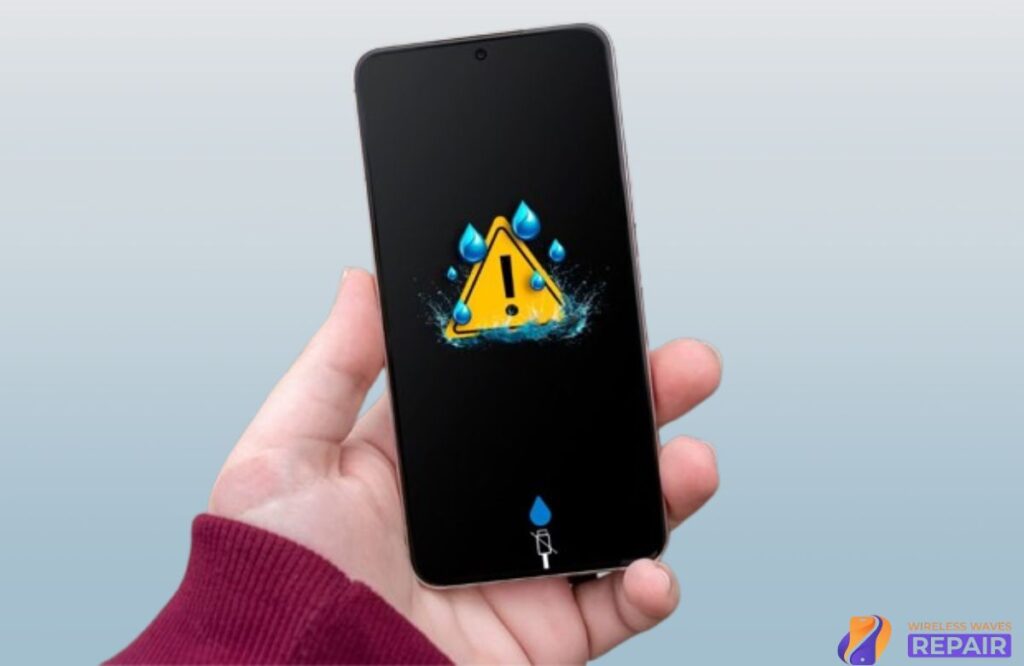Water damage is a common danger to smartphones, especially water entering your phone’s charging port. To effectively get water out from your Samsung phone’s charging port, power off the device to prevent short circuits. Avoid plugging in the charger; hold the phone upside down and gently tap it to encourage drainage. Use a lint-free cloth to dab around the port, allow air drying, and consider placing it in silica gel for faster moisture absorption. Finally, inspect and test the port before charging.
7 Steps to Get Water Out of the Charging Port
Here are the steps you should take.
Step 1: Power Off Your Phone
Turn off the Samsung immediately so that no short circuits happen. Water and electricity are lethal, and damage may increase if the phone is still turned on.
- Hold the power button and tap on the shutdown option.
Step 2: Avoid Plugging in the Charger
Do not attempt to charge your phone when the port is wet. Doing so may cause additional damage to internal components and even be unsafe.
Step 3: Use Gravity to Your Advantage
Place your phone vertically on a stable surface with the charging port facing downward.
- Lightly tap your phone on the palm of your hand to remove water from the charging port.
- Don’t shake the phone hard; this will only push the water deeper into it.
Step 4: Absorb Moisture with a Dry Cloth
Use a gentle, lint-free fabric to dab around the charging port gently. This will help soak up moisture and remove water from the Samsung phone. Avoid placing the cloth directly into the port, which may leave fibers behind or damage the pins.
Step 5: Allow Air Drying
Place your phone in a cool, dry place, allowing gravity to help drain out the water. Make sure the charging port faces down. Air should circulate well to accelerate the process.
Step 6: Use Desiccants for Faster Drying
Place your phone in an airtight container, along with packets of silica gels. Silica gel packets have excellent moisture absorption capabilities. Ensure the ports and the phone are placed in the correct positions to let moisture be absorbed. Wait for at least 24-48 hours.
Step 7: Inspect the Charging Port
Allow enough time for it to dry thoroughly. Then, inspect the charging port with the flashlight to ensure no water droplets are visible. If it is dry, then proceed to step 8.
Step 8: Testing the Charging Port
Once you’re assured the charging port is dry, you may take a look at it as follows:
- Connect your charger and see if the phone starts charging normally.
- Repeat the drying process or explore other remedies if the moisture detection warning continues.
- A slower charging speed may indicate moisture presence or damage to the port.
When to Seek Professional Help
If the above steps do not work, it is probably time to call a Samsung repair technician. Here are scenarios where professional help is recommended:
- The phone continues to display persistent moisture alerts even after drying.
- Charging functionality remains impaired.
- You will find rust or physical damage to the charging port.
A certified repair technician can disassemble the phone, clean the affected areas, and ensure no long-term damage occurs.
What to Avoid When Drying the Charging Port?
When drying a wet charging port, it’s crucial to avoid certain actions that could exacerbate the problem:
- Avoid Using Heat Sources: Do not use hair dryers, ovens, or microwaves to dry your device. Excessive heat can damage internal components and warp the device.
- Do Not Insert Objects: Avoid inserting cotton swabs, tissues, or any foreign objects into the port, as this can push moisture deeper or cause physical damage.
- Avoid Compressed Air: Do not use compressed air to blow into the port; it can force water further inside and may introduce condensation.
- Do Not Shake the Device Vigorously: This can cause water to spread to other internal components, leading to further damage.
- Avoid Immediate Charging: Do not plug in your charger while the port is wet, which can cause short circuits or corrosion.
- Do Not Use Rice: Placing your phone in rice is ineffective and can introduce dust or starch particles into the port, potentially causing more harm.
By avoiding these actions, you can prevent additional damage and promote the safe drying of your device’s charging port.
Preventing Water Damage
Prevention is better than cure. To prevent similar problems in the future, consider the following tips:
- Use a Waterproof Case: Invest in a high-quality one for added protection.
- Avoid Charging in Humid Conditions: Humidity can contribute to moisture buildup in the charging port.
- Seal the Port: Use a protective plug to cover the charging port when not in use.
- Keep the Phone Away from Liquids: Be mindful of your phone’s proximity to water sources such as sinks, pools, or beverages.
Conclusion
In conclusion, effectively removing water in your Samsung phone’s charging port requires immediate action, including powering off the device and avoiding charging while wet. Utilize gravity, a dry cloth, and desiccants to remove moisture, and check the port carefully before testing its functionality. If issues persist, consult a professional technician from Wireless Waves Repair for potential corrosion or damage.
To prevent future incidents, consider using a waterproof case, avoiding humid environments, and keeping your phone away from liquid sources. These precautions can protect your device from water damage and ensure its longevity.

